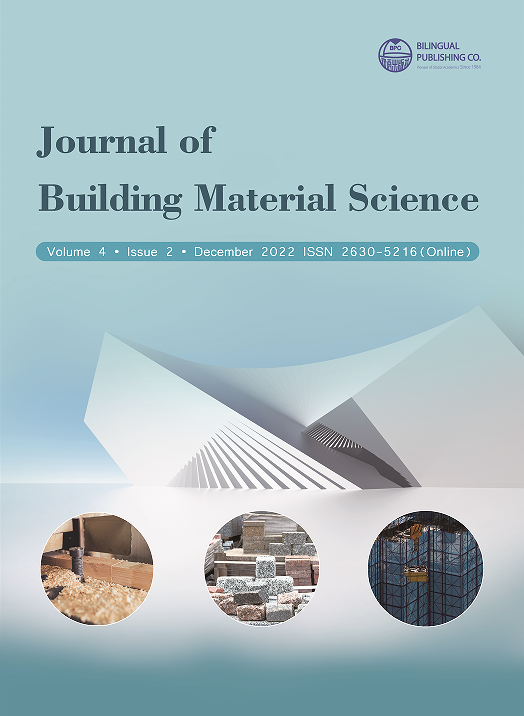
Thermal Analysis of Concrete Mixtures with Recycled EPS Aggregates
DOI:
https://doi.org/10.30564/jbms.v4i2.5251Abstract
Reusing recycled waste materials in buildings is gaining more and more attention for what it offers economic, environmental, and energy benefits; and many researchers are nowadays working on producing new sustainable construction materials incorporating recycled wastes. In this scope, this work uses an experimental approach aiming at understanding the effect of incorporating Expanded Polystyrene (EPS) beads in concrete and proposing thermally improved concrete mixtures for the production of hollow blocks in Lebanese constructions by substituting fine aggregates with recycled products such as EPS in order to promote their insulating properties. Three different diameters of EPS beads (2 mm ~ 3 mm, 3 mm ~ 4 mm and 4 mm ~ 5 mm) are studied with different volumetric ratios (20%, 40%, 60% and 80%) in order to investigate the effect of EPS on the thermal properties of concrete. The results showed that the only the percentage of incorporated EPS beads impacted the thermal performance of the concrete mixtures while the EPS diameters have a negligible effect on the thermal properties of the concrete samples.
Keywords:
Concrete mixtures; Hollow blocks EPS beads; Thermal properties; Thermal insulation; Recycled wastesReferences
[1] International Energy Agency, Transition to Sustainable Buildings, 2013.
[2] Sassine, E., Cherif, Y., Dgheim, J., Antczak, E., 2020. Investigation of the mechanical and thermal performances of concrete hollow blocks. SN Apl. Scie., 2. DOI:https://doi.org/10.1007/s42452-020-03881-x
[3] Yang, J., Du, Q., Bao, Y.W., 2011. Concrete with recycled concrete aggregate and crushed clay bricks. Constr. Build. Mater., 25, 1935–1945.
[4] Medina, C., De Rojas, M.S., Frías, M., 2012. Reuse of sanitary ceramic wastes as coarse aggregate in ecoefficient concretes. Cem. Concr. Comp., 34, 48–54.
[5] Yoshida, A., Terazono, A., Ballesteros, F.C., Nguyen, D.Q., Sukandar, S., Kojima, M., Sakata, S., 2016. Ewaste recycling processes in Indonesia, the Philippines, and Vietnam: a case study of cathode ray tube TVs and monitors. Resour. Conserv. Recycl., 106, 48–58.
[6] Zhang, G.H., Zhu, J.F., Okuwaki, A., 2007. Prospect and current status of recycling waste plastics and technology for converting them into oil in China. Resour. Conserv. Recy., 50, 231–239.
[7] Mohammed, B., Hossain, K. M. A.,Swee, J. T. E., Wong, G., and Abdullahi, M., 2011. Properties of crumb rubber hollow concrete block. J. Cleaner Prod., 23, 57–67. DOI:https://doi.org/10.1016/j.jclepro.2011.10.035
[8] Chen, B., Liu, J., 2004. Properties of lightweight expanded polystyrene concrete reinforced with steel fiber. Cement and Concrete Research, 34, 1259-1263.
[9] Khatib, J.M., Herki, B.A., Kenai, S., 2013. Capillarity of concrete incorporating waste foundry sand. Construction and Building Materials, 47, 867-871.
[10] Bhutta, M.A.R., Ohama, Y., Tsuruta, K., 2011. Strength Properties of Polymer Mortar Panels Using Methyl Methacrylate Solution of Waste Expanded Polystyrene as Binder. Construction and Building Materials, 25, 779784.
[11] Khatib, J.M., Herki, B. A., Elkordi, A., 2019. Characteristics of concrete containing EPS. In Use of Recycled Plastics in Eco-efficient Concrete, 137-165.
[12] Sassine, E., Cherif, Y.,Dgheim, J., Antczak, E., 2020. Experimental and Numerical Thermal Assessment of EPS Concrete Hollow Blocks in Lebanon. J. Materials in Civil Engin., 32, 41-47.
[13] Ganesh Babu, K., SaradhiBabu, D., 2004. Performance of fly ash concretes containing lightweight EPS aggregates. Cement and Concrete Composites, 26, 605-611.
[14] Sayadi, A., Tapia, J. V., Neitzert, T. R., and Clifton, G. C., 2016. Effects of expanded polystyrene (EPS) particles on fire resistance, thermal conductivity and compressive strength of foamed concrete. Constr. Build. Mater., 112, 716–724. DOI:https://doi.org/10.1016/j.conbuildmat.2016.02.218
[15] Karade, S.R, 2010. Cement-bonded composites from lignocellulosic wastes. Constr. Build. Mater. 24, 1323-1330.
[16] Xuan, D.X., Poon, C.S., Zheng, W., 2018. Management and sustainable utilization of processing wastes from ready-mixed concrete plants in construction: a review. Resour. Conserv. Recycl. 136, 238-247.
[17] Mohammed, B.S., Hossain, K.M.A., Swee, J.T.E., Wong, G., Abdullahi, M., 2012. Properties of crumb rubber hollow concrete block. J. Clean. Prod. 23, 57–67.
[18] Ling, T.C., Poon, C.S., Wong, H.W., 2013b. Management and recycling of waste glass in concrete products: current situations in Hong Kong. Resour. Conserv. Recycl. 70, 25–31.
[19] AFNOR - NF EN 12939 Thermal performance of building materials and products - Determination of thermal resistance by means of guarded hot plate and heat flow meter methods - Thick products of high and medium thermal resistance, 2021.
[20] BRAZILIAN ASSOCIATION OF TECHNICAL STANDARDS (ABNT). NBR 15220: Thermal performance in buildings - Part 1, 2, 3 and 4. Rio de Janeiro: 2003.
[21] LEIVA, C., SOLÍS-GUZMÁN. J., MARRERO, M., ARENAS, C. G., 2013. Recycled blocks with improved sound and fire insulation containing construction and demolition waste. Waste Management, v. 33, p. 663-671.
[22] Wang, J., Carson, J. K.,North, M. F., and Cleland, D. J., 2008. A new structural model of effective thermal conductivity for heterogeneous materials with co-continuous phases. Int. J. Heat Mass Transfer, 51, 2389–2397. DOI:https://doi.org/10.1016/j.ijheatmasstransfer.2007.08.028
[23] Dixit A. et al. 2019, “Lightweight structural cement composites with expanded polystyrene (EPS) for enhanced thermal insulation”, Cement and Concrete Composites, vol. 102, pp. 185–197 DOI: https://doi.org/10.1016/j.cemconcomp.2019.04.023
[24] De Moraes E. G. et al. 2019, Innovative thermal and acoustic insulation foam by using recycled ceramic shell and expandable styrofoam (EPS) wastes”, Waste Management, vol.89, pp. 336–344
[25] Gnip I. Ya., Vėjelis S., and Vaitkus S. 2012, “Thermal conductivity of expanded polystyrene (EPS) at 10 ◦C and its conversion to temperatures within interval from 0 to 50°C”, Energy and Buildings, vol.52, pp. 107–111
Downloads
How to Cite
Issue
Article Type
License
Copyright © 2023 Aisha Ayoubi, Emilio Sassine, Joseph Dgheim, Joelle Al Fakhoury, Yassine Cherif, Emmanuel Antczak

This is an open access article under the Creative Commons Attribution-NonCommercial 4.0 International (CC BY-NC 4.0) License.







 Aisha Ayoubi
Aisha Ayoubi





